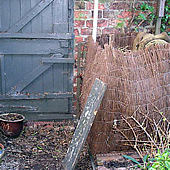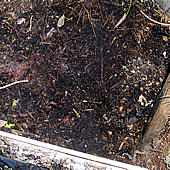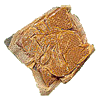All the heaps I have known
A compost heap or compost container has been part of the garden here right from the early days. The allocated space has always been small, as it's a small garden. For a long time the compost container was a rather ramshackle construction made from four corner posts with polythene stapled to it around the sides, wrapped around with bought-in screening material. The compost heap sat on the flowerbed in front of the golden hop, in an area that in summer was rather overshadowed by the growth of the hop, and roses and clematis, on an overhead trellis. Nothing much grew there, so it seemed the ideal place for my compost heap. Previously the compost container was at the end of Millennium Shed, and before that, right near the house - too near - the tiny flies in summer used to drift in through the open windows.
All the ramshackle constructions became annoying, and were never big enough, and always looked ugly. Recently, I've managed to construct a more durable, wooden container that stands in the same corner near to the house, but is fitted with a proper lid, which seems to have dealt with the flies problem.
Contentious compost
Some years ago, I entered a debate about compost making on an online garden forum. I remember the debate getting quite heated and adversarial, following a suggestion that plastic composting bins maybe didn't work very well. It was just that a couple of people I knew thought that plastic composting containers were rubbish, compared to the traditional compost heap. This didn't go down well, as the general consensus of the time was that we should all be committed to promoting the use of compost bins. So, I embarked on this page about compost-making with some trepidation.
I've since heard from people who have found that plastic composting bins have worked well for them. I just don't think that it should be suggested, as it seems to be, that all you have to do is chuck your kitchen and garden waste in a plastic bin. That you just throw it all in there, leave it, and one day before too long you'll take the lid off and find that it's full of something like the stuff you buy in bags as compost from the garden centre.
Compost making does of course take a bit of effort, and a bit of time. Sometimes you can get away without much effort, but then you have to allow more time. Generally I've found that you do have to put a bit of effort into getting the balance right for the necessary processes to take place, and that this involves putting in a mixture of soft, sappy stuff and rather woodier material.
Long-leggedy beasties, legless beasties, all kinds of beasties
Lots of creatures live in compost heaps. Most are the small kinds of beasties you see about the garden anyway - centipedes, woodlice, worms and slugs. Slugs and snails are universally disliked, and we assume they're just there to irritate gardeners by chewing holes in hostas. That they're just on the planet to annoy us. Actually, they do seem to have an important part to play in the eco-system, as far as I can see by helping to eat rotting vegetable matter in compost heaps. I just wish they'd stay in there doing that, and not venture out for fresh lettuce that I've just planted.
Creatures seem to be attracted to the compost heap and congregate there for big insect get-togethers. When you disturb your compost heap to remove or turn its contents you can feel a bit like you're intruding. All these beasties look disorientated and start rushing off for cover. There they were, going about their beasty business chewing on old bits of lettuce that you didn't want, and suddenly you're there sticking your garden fork into their little world. It can feel like you're the police raiding a really good party.
I don't use a garden fork anymore, or even a spade, after encountering a toad in the compost heap one summer. I would be upset if I injured any innocent amphibians. So these days, when taking out or turning the compost, I just put on a pair of big gloves, and stick my hands in instead. I just hope I never meet a grass snake or anything else snake-like.
I do though expect to meet the occasional mouse.
More about the occasional mouse.

Above: not particularly attractive, but essential. Compost-gathering area, partly disguised by handy bendable screening material.
Top left: used teabag - useful compost heap ingredient, and certainly regularly available in this house.
Below: compost. This was once teabags and banana skins and the remains of garden plants.


